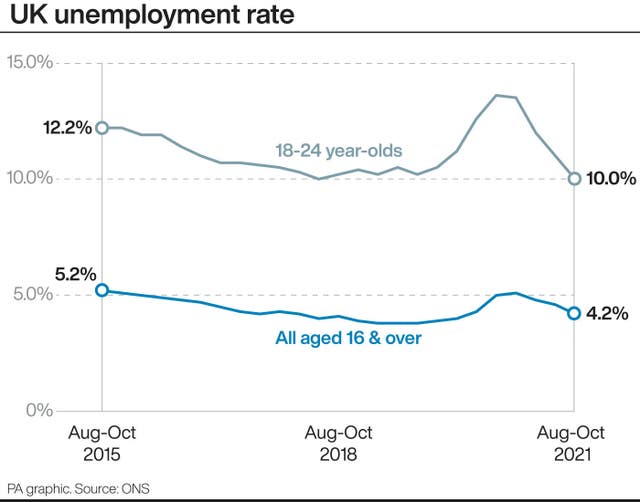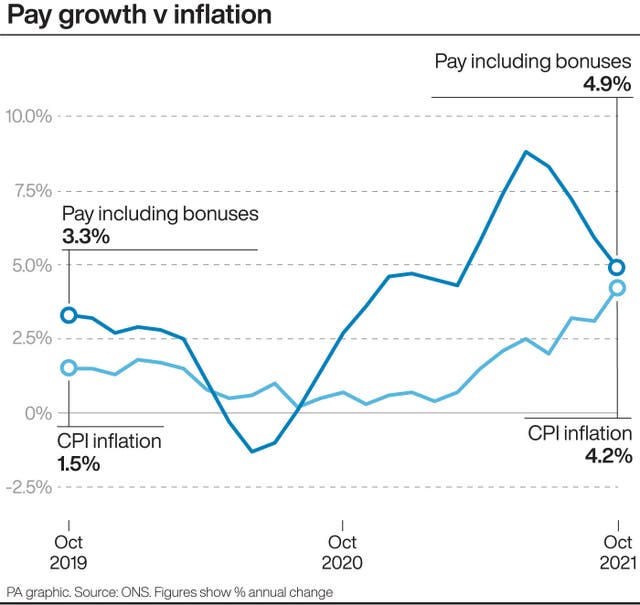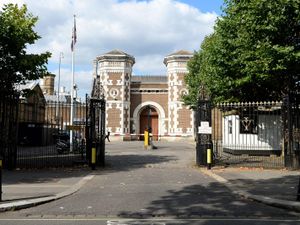Jobs market rebounds further amid record 257,000 rise in UK payrolled workers
The Office for National Statistics said the number of UK workers on payrolls rose by 0.9% between October and November to 29.4 million.

Britain’s jobs market has strengthened further despite furlough ending as the number of payrolled workers jumped by a record 257,000 last month, according to official figures.
The Office for National Statistics (ONS) said there is “still no sign” that the closing of the furlough support scheme in September has affected the jobs market, with the number of UK workers on payrolls rising by 0.9% between October and November to 29.4 million.
The unemployment rate fell once more, to 4.2% in the three months to October, which is the lowest rate since spring 2020 and down from 4.3% the previous quarter.
The ONS said the number of people employed is now 424,000 or 1.5% above levels seen before the pandemic struck.

Vacancies also jumped to another new record – up 184,700 to 1.22 million between September and November, though there were signs of the recruitment crisis easing as the ONS reported an 80,000 drop month-on-month – the first fall since February.
But it comes amid fears over the impact on the economy of the highly infectious Omicron variant of coronavirus and new restrictions to control Covid-19.
All eyes will now be on the Bank of England on Thursday to see if it will hold off on an interest rates rise in light of the latest figures.
Chancellor Rishi Sunak called on Britons to get their booster vaccinations, with concerns growing that more restrictions may be needed.
He said: “To keep safeguarding our economic recovery and the lives and livelihoods of the British people, I am now calling on everyone to keep playing their part and get boosted now.”
The data showed redundancies below pre-pandemic levels, contrary to initial concerns of a wave of job losses once the furlough scheme ended.
Darren Morgan, ONS director of economic statistics, said: “With still no sign of the end of the furlough scheme hitting the number of jobs, the total of employees on payroll continued to grow strongly in November, although it could include people recently made redundant but still working out their notice.

“The number on payroll is now above pre-pandemic levels right across the country.
“Separately, survey findings show much of the recent growth in employment has been among part-timers, who were particularly hard hit at the start of the pandemic.”
Economist Samuel Tombs, at Pantheon Macroeconomics, said the data suggested a “painless end to the furlough scheme”.
He said the figures would likely have prompted the Bank of England to raise interest rates at this week’s decision, “if Omicron had not emerged”.
“Omicron, however, could hit employment in the consumer services sector, which already has suffered from declining demand,” he added.
The ONS figures showed unemployment fell 127,000 to 1.4 million in the quarter to October, while employment lifted 149,000 to 32.5 million.
Average weekly earnings, excluding bonuses, rose 4.3% in the three months to October, easing back from the 5% between July to September as the data no longer sees workers coming off furlough and a recovery in their pay.





